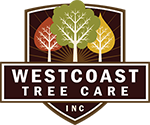As the certified arborists at Westcoast Tree Care make their way through Oregon, bringing preventative tree care services to Beaverton and its surrounding areas, we encounter a variety of tree care questions. While talking to property owners, we often get asked if our certified arborist can top a problematic tree. When this happens, we like to share reasons why tree topping should be avoided while offering alternative tree care services to make a tree safer while preserving its health and beauty.
Effects of Tree Topping
Topping a tree can cause a myriad of problems. Without its canopy and leaves, a tree’s main food source has been taken away causing it to become stressed and unhealthy. Disease is another issue to worry about as large open wounds caused by topping are more susceptible to insect infestations, and rot. These conditions will weaken a tree causing it to become unstable, creating unsafe conditions while increasing overall maintenance. When a topped tree develops even one of many health issues it can be virtually impossible to save it, thus causing it to be removed completely.
Not only does topping a tree affect its health, it can also create dangerous situations while changing the overall look of the tree. Water sprouts that grow in place of missing branches are a good example of an ugly and dangerous problem. In an attempt to replace the photosynthesis generating foliage that was removed, a tree will develop fast growing water sprouts which can obscure views with their dense, upright branches. Water sprouts are also much weaker than normal branches and more likely to break off during a storm causing potential damage your home and property.
Topped trees require constant maintenance to keep health issues and water sprouts under control. They can also reduce the value and aesthetic appeal of your home and property. That’s why it’s important to keep in mind that a topped tree can never return to its original form. Instead, it will look, mangled, stubby and disfigured.
Tree Care Alternatives
At Westcoast Tree Care, we offer a variety of tree care alternatives that can help reduce the hazards of a problematic tree while clearing it of powerlines and views.
- Skirt Raise – Starting from the ground up, our certified arborist will prune and remove lower branches at a level that will make a tree looked balanced and not top heavy. As a healthy alternative to tree topping, skirting removes lower branches that use less energy making a tree more capable of handling bigger cuts.
- Windowing/View Trimming – Windowing is a tree care services that removes branches from the trunk of a tree to help frame a desired view. During this tree care service branches located above and below the “window” are left intact.
- Thinning – Thinning is done by selectively pruning branches to reduce crown density. By keeping the overall shape of a tree intact, thinning allows wind to easily pass through the crown, increasing durability while keeping a tree structurally sound and aesthetically pleasing.
- Removal – If a tree has become hazardous due to declining health, landscape renovations, disease or even storm damage, you may want to consider a tree removal service. At Westcoast Tree Care, our certified arborist can assess the health and stability of a tree, and provide you with safe, and efficient solutions.
Contact Westcoast Tree Care
Topping a tree comes with a variety of risks that can become problematic and even hazardous in a small amount of time. By impacting its health, aesthetics and structural integrity, topping a tree can cause more long-term damage than you’d expect. That’s why it’s important to consider the tree care alternatives above and contact Westcoast Tree Care. Our certified arborist can provide you with a no-cost, no-obligation quote to help increase the safety and beauty of your trees. Call us at 1.800.767.8733.








